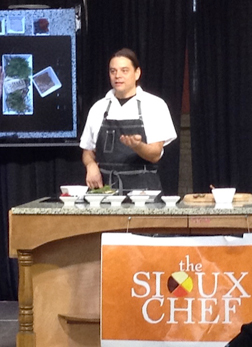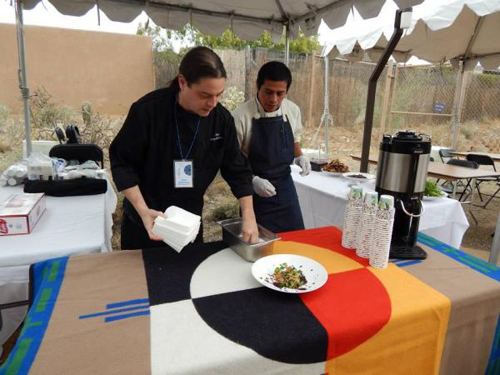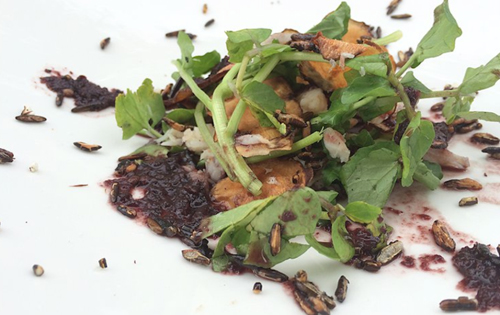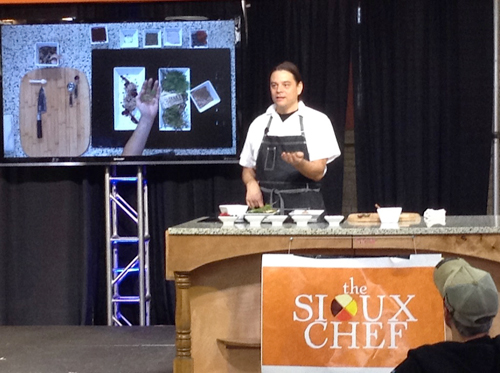Articles
Revitalizing Food
Oglala Lakota Chef Serves Pre-Colonization Menu
News - Articles

Before there was fry bread, there were sage, white pine,
chokecherries and wild buffalo.
Before Europeans unloaded wheat and sugar cane and introduced
beef to Turtle Island, Natives hunted and fished. They planted
potatoes, squash and corn, and they flavored their food with purslane,
rose hips and dandelion.
That traditional diet, or what Chef Sean Sherman calls the "pre-colonization diet", is the bedrock for a new
restaurant set to open this fall in the Twin Cities area of Minnesota. Sherman, who is Oglala Lakota,
plans to use only indigenous foods in the restaurant, which he has appropriately named The Sioux Chef.
"I’m not using any European ingredients", he said. "Everyone knows what meat was here, but I was interested in the other things—how
they dried corn and squash; how they ground things into flour; and all the beans, berries, wildflowers and tree fruits. There are
plenty of flavors to play with."
Sherman, 40, was born in Pine Ridge and learned some of the traditional ways of preparing and preserving
food from his grandfather. His great-grandfather fought in the Battle of the Little Bighorn,
he said, so his grandfather was among the first generation of Lakota to live on the reservation and attend mission schools.

"My family knows what was growing on the prairies", Sherman said. "When I have a big pot of chokecherries or buffalo
simmering on the stove, or when I’m out there picking things from the forests or prairies, it's definitely nostalgic.
When I’m out there gathering sage, all those flavors bring back memories."
Sherman started working in restaurants at age 13 and continued while studying business at Black Hills State College,
in Spearfish, South Dakota. After college, he moved to Minneapolis, where he pursued a serious culinary career,
eventually becoming a chef at age 28.
Sherman was sought after by restaurant owners who wanted a redesign or "rebranding" of existing kitchens, said Jael Kampfe,
Sherman’s stepmother and owner of a working guest ranch in Montana. Several years ago, Kampfe hired
Sherman to create a new menu and dining experience for clients.
"What I really love about what he is doing is the relationship he creates between food and culture", Kampfe said. "Food
is his central focus and he creates everything around it."



Always drawn to local, organic foods, Sherman quickly found a niche working directly with farmers and ranchers to put
quality, fresh meals on restaurant tables. He studied indigenous ingredients in Spain and Mexico, establishing
communities around locally produced food and a return to regions’ indigenous flavors.
When it came to preparing foods native to his own people, Sherman found he had to do a lot of research.
Many tribes cite fry bread as part of the traditional diet, he said, but he needed to dig deeper into the past.
"I realized there wasn't a lot of information out there in terms of how to process foods or what
they really ate", he said. "I spent a long time studying wild foods. I talked to people and got oral stories.
A lot of it had to come from history books and other accounts of how things were."
His studies took him to reservations in Wyoming, Montana, Minnesota, Wisconsin and the Dakotas, and
resulted in dishes like smoked turkey wasna, mixed berry wojapi, wild rice flatbread and grilled duck.
Sherman, who often does food demonstrations or hosts discussions about healthy eating, decided earlier this year that he
wanted to open a restaurant and serve traditional Lakota and Ojibwe foods. He’s now catering in the Twin Cities area
and plans to open that restaurant by December—once he finds the right space.
When The Sioux Chef opens, patrons can expect a fine dining experience that will appeal to simple and
sophisticated palates. Sherman, who is equally comfortable picking berries in the woods and serving five- or six-course
meals to black-tie guests, plans to use his restaurant to blend modern cooking techniques with traditional cuisine.
"It’s really a family-style concept of dining, but with pre-colonial foods," he said.
"My goal is to let the dishes speak for themselves."
According to Kampfe, the restaurant couldn’t open at a more opportune time.
"This is really vital for the future of culture", she said. "We have all this talk about revitalization of language
or ceremonies, but there’s not enough talk about revitalizing food."


Source:
http://indiancountrytodaymedianetwork.com





